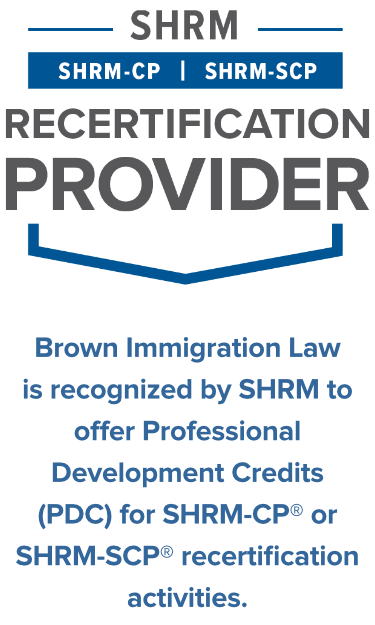This memo is intended for general information purposes only, relating to the impact of a layoff or other termination on employment-based visa sponsorship from the foreign worker’s perspective. This memo does not address employment law, tax, or other implications and is not a substitute for individual legal advice.
Impact of Termination on Employment-Based Nonimmigrant Status
This memo only addresses concepts and considerations related to certain nonimmigrant visa classifications. Review our memo on the Impact of Termination on Employment-Based Green Card Process for more information in that regard.
Important note for individuals with pending I-485: individuals with a pending I-485 Adjustment of Status (“AOS”) application should NOT rely on the information below without seeking legal advice. A pending I-485 itself may allow the applicant to remain in a period of authorized stay in the U.S., and leaving the U.S. or pursuing certain options discussed below could jeopardize that application.
INTRODUCTION
If a foreign worker’s employment is terminated for any reason, they will generally lose their employment-based nonimmigrant status. For some types of visa sponsorship, such as H-1B, the employer has an obligation to notify the government of the H-1B worker’s termination and withdraw their nonimmigrant petition. The foreign national would still entitled be to any applicable grace period, even if their underlying status is withdrawn, but it is important to understand that allowance and take the necessary steps to remain in the U.S. or leave the country in a timely manner.
Overstaying the allowable period following the termination of your employment can have serious consequences on your nonimmigrant status and future processes. This memo provides general information to help avoid any issues in that regard but does not address every possible consideration or serve as a substitute for legal advice. Individuals should contact a licensed immigration attorney to fully understand their options, potential risks, and other case-specific considerations to determine the best path forward.
UNDERSTANDING YOUR GRACE PERIOD (IF APPLICABLE)
H–1B, H–1B1, L–1, O–1, TN, E–1, E–2, and E–3 Employees:
Individuals in H–1B, H–1B1, L–1, O–1, TN, E–1, E–2, or E–3 status may benefit from a grace period of up to 60 days following the termination of their employment. More specifically, the individual may remain in the U.S. for 60 days following the end of their employment OR until the end of their authorized validity period, whichever is shorter. Individuals are not authorized to work during this period.
For example, if your last day of employment is January 1, 2025, and your underlying status is valid through December 1, 2025, you must timely file a new petition to extend your stay in the U.S. or depart the country by March 2, 2025 (60 days from January 1st). However, if your last day of employment is January 1, 2025, and your underlying status expires on February 15, 2025, you must file a new petition to extend your stay or depart the United States by February 15, 2025, since the remaining validity period is shorter than 60 days.
The 60-day grace period must be used in a single period of consecutive days during the authorized validity period. If you leave the U.S. during that period, your grace period will end upon your departure, and you will not be able to recapture any remaining time. If you are outside the U.S. when terminated and do not return before your last day of employment, the grace period does not apply. The employer’s withdrawal of the nonimmigrant petition, if applicable, does not affect the 60-day grace period.
If you seek to remain in the U.S. beyond any applicable grace period, a new employer must file a nonimmigrant petition to extend your stay or you must file an application to change status, which must be received by USCIS before the end of the grace period or authorized validity period, whichever is shorter. Otherwise, you must depart the U.S. before the end of that period.
F-1 Students (CPT, OPT, & STEM OPT):
An employee in F-1 status working pursuant to Curricular or Optional Practical Training (i.e., CPT or OPT including STEM OPT) does not immediately fall out of status based on the termination of that employment. F-1 students are generally given a 60-day grace period at the end of the authorized period on their latest I-20. Unlike grace periods for other status types, the F-1 grace period starts at the end of their authorized program, not upon termination of employment. However, to maintain proper status during any period of OPT and STEM OPT, individuals must continue to comply with all terms and conditions of their F-1 program, including the maximum period of unemployment.
Individuals in F-1 status are allowed a total of 90 days unemployment during their one-year post-completion OPT period, plus an additional 60 days for two-year STEM extensions, if applicable (for a total of 150 days of unemployment allowed during three-year period of OPT and STEM). Therefore, terminated employees in F-1 status must find a new U.S. employer, change status, or depart the U.S. within the 60-day grace period following the end of their authorized program or when they reach the maximum days of unemployment allowed for their OPT or STEM program, whichever comes first. Individuals in F-1 status must also notify their DSO of any changes in their employment.
OPTIONS FOR REMAINING IN THE UNITED STATES
The options for maintaining lawful nonimmigrant status in the U.S. following the termination of employment-based visa sponsorship vary depending on individual circumstances. We provide an overview of some of the more common options below, noting that each situation must be reviewed separately to determine eligibility, risks, and other factors on a case-by-case basis, including other options not listed below
Nonimmigrant Sponsorship by New U.S. Employer:
Typically, to join a new employer without having to depart the U.S., a new employment-based petition must be filed with USCIS before the end of any applicable grace period or status expiration. One exception may be individuals in F-1 status, which must follow the proper procedure of notifying their school of a new employment opportunity, rather than filing with USCIS.
Individuals in H-1B status may benefit from AC-21 portability, which allows them to begin working for the new employer as soon as a bona fide H-1B Change of Employer petition is filed with USCIS. The AC-21 portability allowance is specific to H-1B status, if all relevant criteria are met, other types of visa petitions require USCIS approval before the beneficiary may begin working for the new employer.
Changing Status to B-1 or B-2 Visitor:
Another option to remain in the U.S. may be to change to a visitor status – B-1 (Business Visitor) or B-2 (Tourist). However, B-1/B-2 status does NOT provide work authorization. If lawfully present in the U.S., a change of status to B-1/B-2 is filed with USCIS on Form I-539, Application to Change Nonimmigrant Status. The I-539 application must be received by USCIS before the end of any applicable grace period. The timely filing of a bona fide I-539 application with USCIS provides a period of authorized stay in the U.S. while that application is pending, and the applicant must remain in the U.S. until it is adjudicated. If the applicant leaves the U.S. while the I-539 application is pending, it will be considered abandoned and automatically denied.
Changing to Dependent Status:
If the terminated worker has a spouse on their own employment-based visa status, the terminated worker may change to the dependent status of their spouse. For example, a terminated H-1B worker with a spouse on their own H-1B status may change status to H-4; if their spouse is in the U.S. on L-1 status, the terminated worker could change to the dependent status of L-2S; if the spouse is employed in TN status, the terminated worker could change status to TD as their dependent; etc.
Work authorization for dependents varies by status type. Some individuals in a dependent status are work authorized incident to status (e.g., L-2S, E-3S), whereas dependents of other nonimmigrant classifications like are not permitted to work under any circumstances (e.g., TD, F-2, O-3). Some dependent statuses, like J-2 and H-4 (which are only eligible for work authorization in certain circumstances), must file an I-765 application with USCIS to obtain an Employment Authorization Document (“EAD”) before accepting employment, if certain requirements are met.
The terminated worker may file an I-539 application with USCIS requesting a change of status to the relevant dependent classification from within in the United States. The I-539 application must be received by USCIS before the end of any applicable grace period. The timely filing of a bona fide I-539 application with USCIS provides a period of authorized stay in the U.S. while that application is pending, and the applicant must remain in the U.S. until it is adjudicated. If the applicant leaves the U.S. while the I-539 application is pending, it will be considered abandoned and automatically denied.
SPOUSES & CHILDREN IN DEPENDENT STATUS
The termination of a nonimmigrant worker’s employment will also impact the status of any spouse or child in a dependent status. If a spouse or children are in a dependent status contingent on the terminated worker’s employment (e.g., H-4 dependents of H-1B; L-2 dependents of L-1; etc.), their status will generally be impacted in the same way as the principle beneficiary – i.e., if you lose your nonimmigrant status due to the termination of your employment, any dependents of that status will lose their status as well. If the terminated worker is eligible for a grace period following their last day of employment, their dependents will be afforded the same allowance. If a spouse is work authorized in a dependent status, their work authorization will remain valid through the end of the terminated worker’s grace period, if any.
Like the primary beneficiary, spouses and children in a dependent status must take action to extend their stay or depart the U.S. before the end of the applicable grace period. It is commonly assumed that dependents will remain in lawful status so long as the primary beneficiary takes action to extend their stay, but that is not always true. Dependent statuses are not automatically extended based on the extension of the primary beneficiary’s status, so separate action may be required to allow dependents of the terminated worker to remain in the U.S. beyond any applicable grace period. This is always true when the terminated worker changes status to a different visa classification, in which case any dependent spouse or child must each take action to change their own status or depart the U.S. before the end of any applicable grace period.
CONCLUSION
It is important to note that every situation is unique. This memo provides a high-level overview of key points for maintaining proper status or timely departing the U.S. upon the termination of a nonimmigrant worker, but it is not comprehensive of all factors, status types, or individual circumstances. Individuals should consult a licensed immigration attorney to fully understand their options and all relevant considerations to determine the best path forward.



